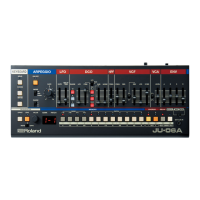[RATE] knob # # Specifies the note length for each step of the arpeggiator.%
# # # 4 (quarter note)!
# # # 4t (quarter note triplet)!
# # # 8 (8th note)!
# # # 8t (8th note triplet)!
# # # 16 (16th note)!
# # # 16t (16th note triplet)!
# # # 32 (32nd note)!
# # # 32t (32nd note triplet)!
# # # 64 (64th note)!
###64t (64th note triplet) !
3 LFO!
Here you can create cyclic change (modulation) in the sound. !
CONTROLLER ## EXPLANATION!
[RATE] slider # # Specifies the LFO’s modulation speed.!
[DELAY TIME] slider # Specifies the time from when the tone sounds until the LFO !
###reaches its maximum amplitude. !
4 DCO%
Here you can select the waveform that determines the character of the sound, and specify its pitch. !
CONTROLLER ## EXPLANATION!
RANGE [16] [8] [4] # Specifies the octave of the oscillator.%
buttons!
[LFO] slider # # Allows the 3 LFO to modulate the pitch, producing a vibrato !
###effect !
[PWM] slider # # When the [LFO/MAN/ENV] switch is “MAN” (MANUAL) !
###Adjusts the value of the pulse width. !
###!
###When the [LFO/MAN/ENV] switch is “LFO” !
###Adjusts the depth of modulation produced by the LFO. !
###!
###When the [LFO/MAN/ENV] switch is “ENV” !
###Adjusts the depth of modulation produced by the ENV. !
# # # WHAT IS PULSE WIDTH?!
# # # Pulse width is the amount of the upper portion of the pulse wave, expressed as #!
# # # a percentage of the overall wavelength. !
###!
# # # If the upper and lower widths are not the same, the waveform is called an !
# # # asymmetric pulse wave.%
[LFO/MAN/ENV] switch #Selects whether the pulse width value is the fixed value !
# # # specified by the [PWM] slider (MAN), is modulated by the 3 !
# # # LFO (LFO), or is modulated by the 8 ENV (envelope). !
[SQUARE/PULSE] # Selects the waveform that is the basis of the sound.!

